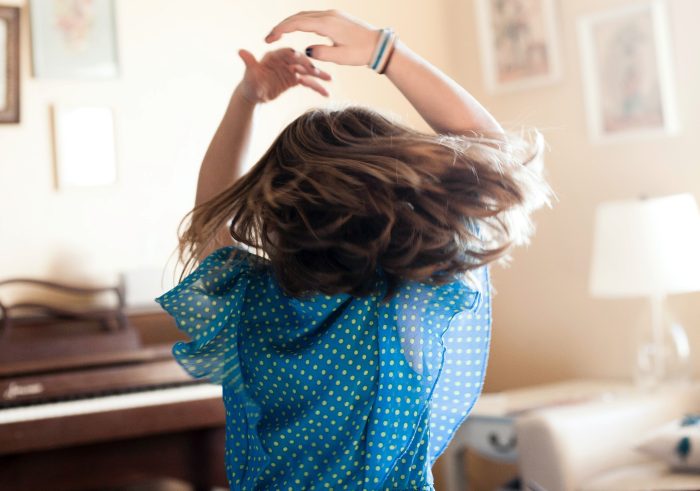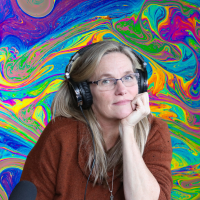This past week on the podcast I co-host, we interviewed a guest who calls himself, “The World’s First Party Coach.”
We learned about how he, after working many jobs that didn’t seem to be just right, invented the “Party Coach” profession due to his realization that after attending over 100 raves, dance parties, and social gatherings, this was his true passion.
During the interview, a part of me perked up asking, “What would it be like to really let go, attend a rave, dress up, show skin, just be up for anything?” I imagined myself dancing around, in some sparkly spandex costume, with my face painted, twirling, and giving in to the music and being in the moment. Upon sitting with this imagery, an inner delegation emerges and says, “F*ck no!” and rolls out a scroll of fears like Santa’s naughty list.
That seemingly benign phrase, “Dance as if no one is watching,” pops into my head. It’s inspirational, right? To let everything go. To surrender. It should be freeing and relaxing. So why the fudge does it sound so terrifying? Why, instead of letting go, does my whole body tense up at the suggestion?
Being a trauma therapist and a trauma podcast co-host, I, of course, revisit my childhood memories to figure this out. The answer hits me and it’s an overwhelming wave of grief. “Ahh, yes. That’s why I haven’t looked at this particular grieving place. That’s why I freeze up. Because it’s almost too painful to look at.”
My insight to why that piece of advice doesn’t work for me is because as a child, nobody was watching me. Not my mom, not my dad, not a caring grandparent, not a loving relative, not a fun babysitter. Around the age of seven, I would get home from school with my younger brother, aged five, plop down my backpack, and sigh into the void of our empty house. Sometimes, I would roam the neighborhood searching for something to do. Sometimes, I would make cinnamon toast so inept that I would almost burn the kitchen down.
I was born in 1968, prime latchkey kid era. I had a dirty shoelace around my neck with our key on it. What was happening in the 1970s is that mom went to work, which, on par, was great for women everywhere. My mom was a real estate agent, a profession where there were few boundaries and the client came first.
But it wasn’t just that my mom wasn’t physically around. She also didn’t seem to care who I was, where I was, maybe even why I was. I existed. That I had a mind and a story worth exploring was beyond her. Don’t even get me started on American Dads—that’s a whole other blog. She didn’t ask me how my day went. She didn’t grab me and pull me into her after a long day of showing houses in her Belk’s business attire. She didn’t say, “I’m so glad to see you, honey!” She didn’t stroke my hair lovingly. When I was devastated that I didn’t make the cheerleading team in second grade (it’s the South, where cheerleading starts early), no one asked me if I felt like dying (which I did).
So, when I hear the phrase, “Dance as if no one is watching,” a rage bubbles up. I want to personally blame whoever put out that nonsensical trauma-uninformed platitude (and maybe punch them in their stary-eyed, blissed-out face). I imagine that only someone who was watched and delighted in could make up that phrase. That person gets that freedom to dance when others are watching or alone if they choose to because they’ve had the gift of being witnessed, appreciated, and celebrated.
What is it to not be watched as a child? Childhood creative impulses—the joy of what it is to be a fresh human in the world—emerge and quickly wither like seeds scattered in a desert. Without the needed nurturing elements of attention, curiosity, and delight, the joy of being seen becomes despair and then shame.
There is one memory that is burned into my neural pathways that doesn’t seem like a big deal if it happened once, yet I believe it captures the felt sense of pervasive dejection.
I was around four years old, was scribbling away as a kid does, and formed something that I was sure was a lower case “e”. I ran to my mom and showed her my paper excitedly exclaiming, “I made an e!” She was getting dressed, hair wrapped in a towel, and said three words, “No, it’s not,” I was finished for the rest of my childhood and to this day bestowing any excitement toward her as a means of connection or being seen.
I have often said to therapists that it feels like I was done with my parents by the time I was five. I was already self-sufficient and swallowing disappointment so I would not feel the sting of emotional neglect. I have recently deepened into that inner child work with my therapist. There is a sweet, desperate child longing for hugs, hair stroking, and backrubs, and the other kid who is tough, dirty, potty-mouthed, and who learned to need nothing. Re-parenting those two is no easy task; it requires love, which was in short supply in the neglected experience.
I do have scant memories of dancing with abandon. It was 1974 and the six-year-old me was wildly grooving out to “The Age of Aquarius”. Being born in February, I was sure they were singing directly to me. Then I see a faint memory of the eight-year-old me spinning and leaping about to Nadia’s Theme while imitating the darling Romanian gymnast from the 1976 Olympics that everyone wanted to watch. The key in these memories is that to be that free, I had to make sure no one was watching. The damage was already done and my poor little kid-self was seeing if she could grow the authenticity garden by herself, alas she could not. In the absence of nurture, care, and delight, the dance of abandon became the dance of abandonment and it had to be put away.
As a middle-aged adult contemplating the experience of really letting it all go with strangers in an environment that, I guess, is designed to accommodate the dance of abandon, I freeze and feel fear. It isn’t as if I haven’t gone a little wild here and there in adulthood, yet the trauma response that controlled parts of myself stay very close and advise that it is best to put that sh*t away.
Authentic expression feels impossible to sustain as a practice. It’s just too risky, too lonely, too unknown. My controlling parts cover up the shame and have no shortage of evidence of why expressing with abandon is a terrible idea. “People just go too far…get too lost…spew all that hippy bullsh*t, aren’t being authentic, wasting time, not being adults…what losers!” Yet if I get really honest, it goes back to nobody was watching and my little buds of creative expression died on the vine, and sparks of spontaneity never caught fire in that vacuum.
The phrase “no one is watching” is devastating to the inner neglected child. I have learned to mask that pain so perfectly. So many layers of protection have crafted something that looks pretty authentic, spontaneous, irreverent, funny. Over 30 years of on-and-off therapy and then becoming a therapist are part of the good fight against those parts of me that manage the terror of being truly seen. Yet, I continue this path of healing, and now I am seeing those little dancers from my memory that had to do it alone. I can now hear them saying, “Remember this. Remember this joy.”
I am actually grateful to my protective parts, the parts of my personality that showed up to shield the sweet little joyful self, the parts that had to wrap her up and put her in a safe box, sequestering her joy and frivolity and “abandon” for nearly 50 years. Perhaps in that box, they are mixing with even older seeds that were put there long before my birth, seeds that were protected from even more cultural trauma—generations of poverty, war, neglect, inequality, misogyny, and sexual and physical trauma.
As I sit here feeling into the invitation to come to play with abandon with the strange humans you might meet at a festival or a rave, I can sense that child whisper, “Remember this joy.” And I can feel the protectors that are not sure I will survive shame. Yet, what is different is that something, someone wiser is present, the therapy is working, being born at this time in history—who knows. But some capacity is becoming more and more available in my system. It might be that I can actually feel and put words to it and let people know how hurt I was, how hurt I still am.
Tears of grief, hope, fear come as I enter this world of possible playful abandon and turn away from a history of abandonment.
The wisdom out there tells me that in this time, day, age, you actually are here to live out loud.
In fact, it is imperative that we find the courage to live out loud, because the living seeds of joy despite my neglectful experience and my ancestor’s trauma may have an expiration date.
I guess the path to healing is to learn to dance as if everyone is watching!
For more on this topic, check out Episode 25 of Latchkey Urchins & Friends Podcast entitled Being Scene: The Healing Power of Parties, Raves, and Social Gatherings.

 Share on bsky
Share on bsky







Read 18 comments and reply